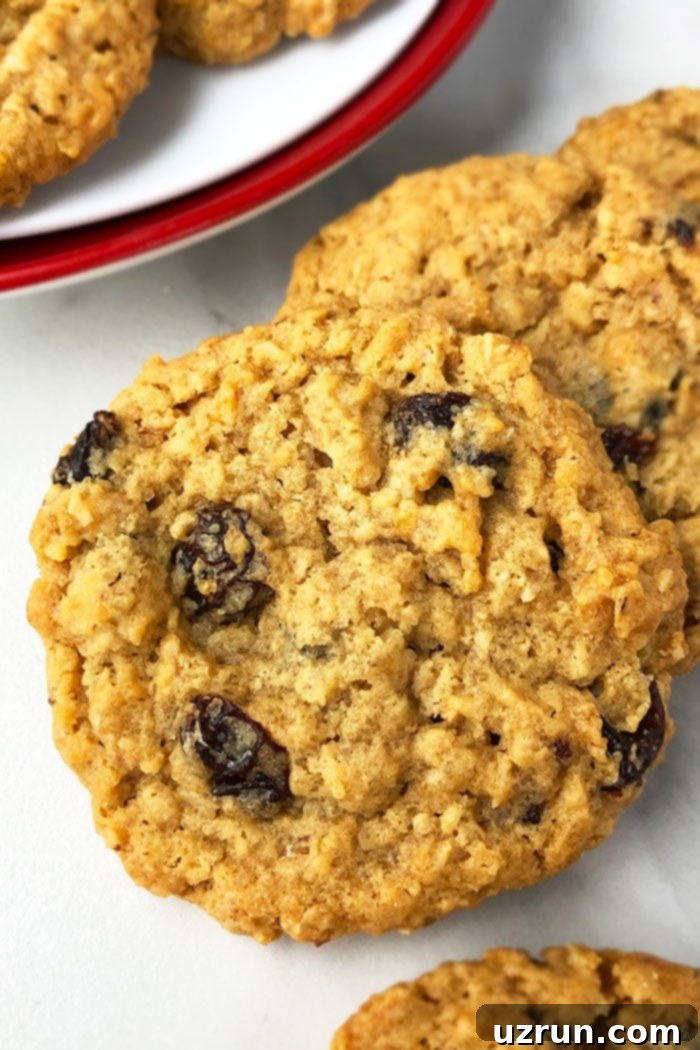The Best Soft and Chewy Oatmeal Raisin Cookies: A Classic Homemade Recipe
Prepare to fall in love with the ultimate classic treat: these incredibly soft and chewy oatmeal raisin cookies. Crafted from scratch with simple, wholesome ingredients like hearty oats, plump raisins, and rich butter, this recipe guarantees a homemade delight that’s both quick to prepare and utterly irresistible. Forget dry, crumbly cookies; ours are designed for that perfect melt-in-your-mouth texture that makes them an enduring favorite.
Often overlooked in favor of their chocolate-laden counterparts, these oatmeal raisin cookies are truly a dark horse in the world of baked goods, giving even the best chocolate chip cookies a serious run for their money. While they might not always win beauty contests with their rustic charm, their deep, comforting flavor more than compensates. They’re guaranteed to be a crowd-pleaser at any gathering, standing proudly alongside other favorites like Iced Oatmeal Cookies and delicate Oatmeal Lace Cookies. With a blend of warm spices and the natural sweetness of raisins, these cookies offer a nostalgic taste that brings warmth and joy with every bite.
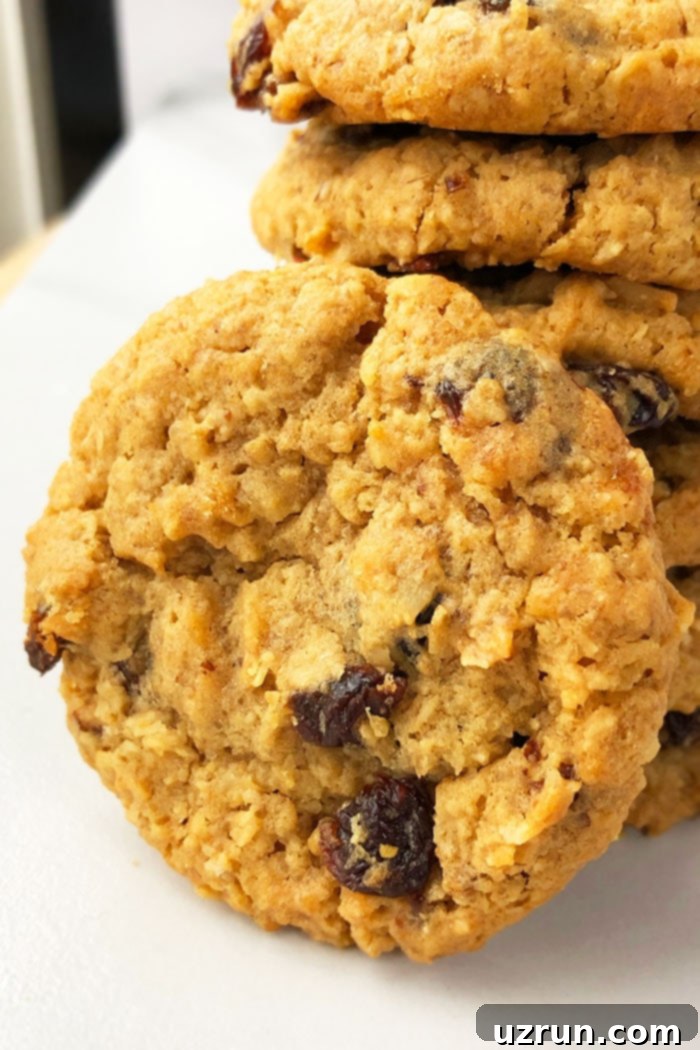
Mastering the Art: How to Make Perfect Oatmeal Raisin Cookies from Scratch
Crafting homemade oatmeal raisin cookies is a delightful and rewarding experience. This simple step-by-step guide will walk you through the process, ensuring your cookies turn out perfectly soft, chewy, and full of flavor. The key lies in careful ingredient mixing and proper baking techniques, leading to a batch of cookies everyone will adore.
- Cream Butter and Sugars: Begin by creaming together softened unsalted butter with both brown sugar and granulated sugar. This process should take a few minutes, resulting in a light and fluffy mixture. The air incorporated here is vital for a tender cookie texture, and the combination of sugars contributes to both chewiness (brown sugar) and crisp edges (granulated sugar).
- Mix in Remaining Wet Ingredients: Next, incorporate the egg, a tablespoon of molasses (or honey/maple syrup for a slight variation), and vanilla extract. Beat these thoroughly until they are well combined into the sugar and butter mixture. Molasses adds a distinct depth of flavor and contributes significantly to the cookie’s characteristic chewiness and rich color.
- Combine Dry Ingredients: In a separate bowl, whisk together your all-purpose flour, old-fashioned rolled oats, cinnamon powder, nutmeg powder, and baking soda. Sifting the flour and spices beforehand can prevent clumps and ensure even distribution, leading to a consistent texture throughout your cookies.
- Gently Combine Wet and Dry: Gradually add the dry ingredient mixture to the wet mixture, mixing until just combined. Be careful not to overmix at this stage; overworking the dough develops gluten, which can lead to tough, dry cookies instead of the desired soft and chewy texture. A few small lumps are perfectly fine.
- Stir in Raisins: Finally, fold in the raisins until they are evenly distributed throughout the dough. The dough will likely be quite sticky at this point, which is normal. Don’t worry about perfect distribution; a rustic look is part of their charm.
- Chill the Dough: This crucial step makes the dough much easier to handle and prevents the cookies from spreading too much during baking. Chill the cookie dough in the refrigerator for at least 30-40 minutes. This allows the butter to firm up and the flavors to meld beautifully.
- Form Cookie Balls: Once chilled, scoop out small, uniform portions of the dough using a cookie scoop or a spoon. Roll them into smooth balls and place them on a baking tray lined with parchment paper, ensuring enough space between each cookie for spreading.
- Bake to Perfection: Bake the cookies in a preheated oven at 350°F (175°C) for 10-12 minutes. Look for golden brown edges and centers that are still slightly soft. This slight softness in the middle is the secret to achieving that wonderfully chewy texture once cooled.
- Cool and Enjoy: Remove the cookies from the oven and let them cool completely on the baking tray. They will continue to firm up as they cool. Once cool, they’re ready to be devoured!
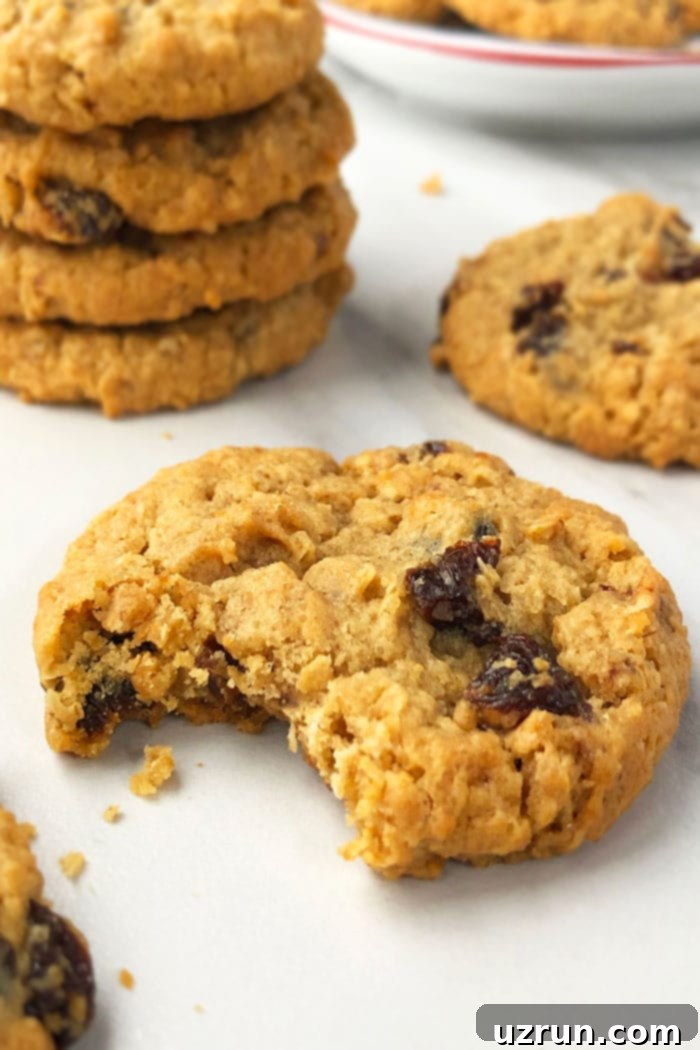
Troubleshooting Common Oatmeal Raisin Cookie Problems: Why Are My Cookies Dry?
There’s nothing more disappointing than anticipating a soft, chewy cookie and biting into a dry, crumbly one. Here are the two most common culprits behind dry oatmeal raisin cookies and how to avoid them:
1. Over-mixing the Dough: This is arguably the most frequent mistake. When you overmix cookie dough, especially after adding the flour, you activate the gluten proteins. Gluten provides structure, but too much development makes baked goods tough and dry. Think of it like kneading bread – great for chewy loaves, but not for delicate cookies. Always remember to mix your dry ingredients into your wet ingredients until *just combined*. A few streaks of flour or small clumps are perfectly acceptable; it’s better to slightly undermix than overmix.
2. Over-baking: Leaving cookies in the oven for too long is another common cause of dryness. High heat for extended periods evaporates the moisture from the dough, leading to a hard, brittle cookie. Cookies continue to bake slightly even after they’re removed from the oven due to residual heat. To prevent over-baking, look for visual cues: the edges should be golden brown and firm, but the centers should still appear slightly soft and set. When in doubt, it’s always better to underbake by a minute or two, as you can always pop them back in, but you can’t reverse an overbaked cookie.
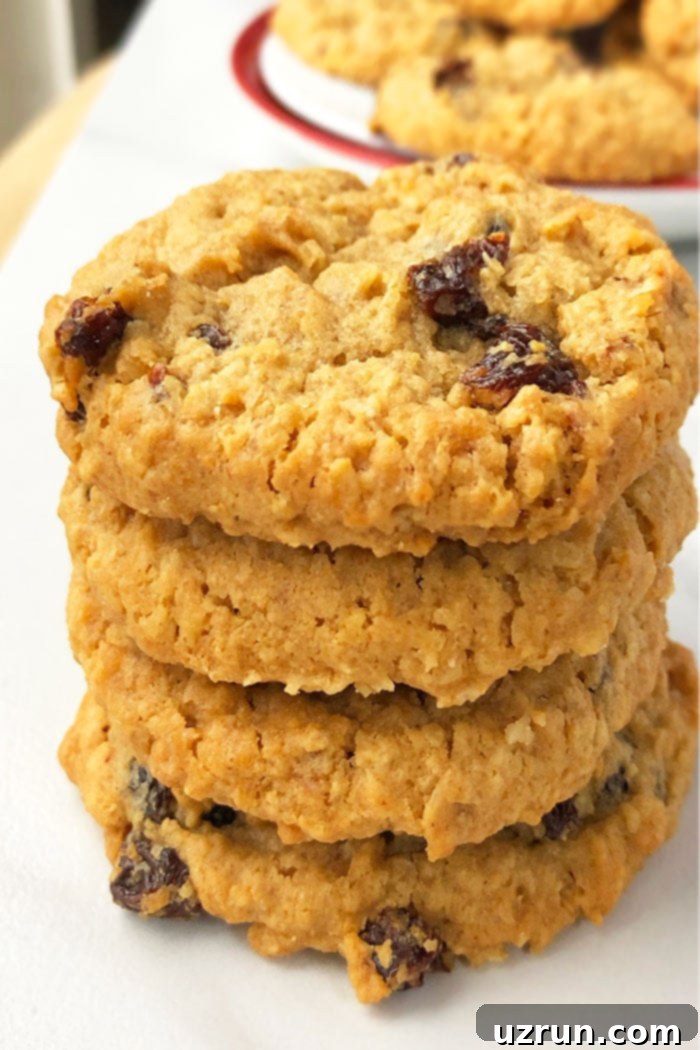
The Great Oat Debate: Can You Use Quick Oats in Oatmeal Cookies?
While quick oats (also known as instant oats) might seem like a convenient substitute, I strongly advise against using them for this particular oatmeal raisin cookie recipe. The reason lies entirely in the texture. Old-fashioned rolled oats are minimally processed, retaining more of their natural shape and integrity. This results in a much more substantial, satisfyingly chewy texture in the final cookie, which is a hallmark of a truly great oatmeal cookie.
Quick oats, on the other hand, are steamed, rolled, and cut into smaller pieces, allowing them to cook faster. When baked into cookies, they break down more easily, leading to a softer, less chewy, and sometimes even gritty texture that can be quite unpleasant. For that classic, hearty, and perfectly chewy oatmeal raisin cookie experience, stick with old-fashioned rolled oats. They truly make all the difference!
Creative Variations for Your Easy Oatmeal Raisin Cookie Recipe
This classic oatmeal raisin cookie recipe serves as a fantastic base for endless customization. Feel free to get creative and tailor them to your personal preferences. Here are some delightful variations to explore:
- Make it “Healthier”: For a slightly more wholesome spin, try replacing half of the all-purpose flour with whole wheat flour. You could also slightly reduce the quantity of sugar. Be aware that these adjustments might subtly alter the overall flavor and texture, resulting in a denser cookie.
- Oatmeal Raisin Chocolate Chip Cookies: Who says you can’t have the best of both worlds? Mix in a handful of mini chocolate chips (dark, milk, or white chocolate work well) along with the raisins for a delightful chocolatey twist.
- Add Nuts for Crunch: Introduce a lovely textural contrast and nutty flavor by incorporating roughly chopped walnuts, pecans, or almonds into the dough. Toasting the nuts lightly before adding them can enhance their flavor profile even further.
- Explore Other Dried Fruits: Raisins are classic, but other dried fruits can be equally delicious! Try adding dried apricots (chopped), cranberries, or dried mangoes for different flavor notes and bursts of color.
- Boost with Bananas: For a naturally sweeter and extra moist cookie, mash half a ripe banana and mix it into the wet ingredients. This adds a subtle fruity flavor and helps keep the cookies incredibly tender.
- Go Gluten-Free: Easily adapt this recipe for those with gluten sensitivities by substituting all-purpose flour with a high-quality gluten-free flour blend. I highly recommend Bob’s Red Mill 1:1 Baking Flour for its excellent performance in baked goods, though the texture might be slightly different.
- Add Citrus Zest: Brighten up the flavor profile with a hint of citrus. Grate in some lemon zest, orange zest, or even lime zest for a refreshing, aromatic kick that complements the spices beautifully.
- Embrace Coconut: For a tropical spin, stir in shredded coconut, coconut flakes, or even toasted coconut flakes. The toasted flakes will add an extra layer of crunch and depth of flavor.
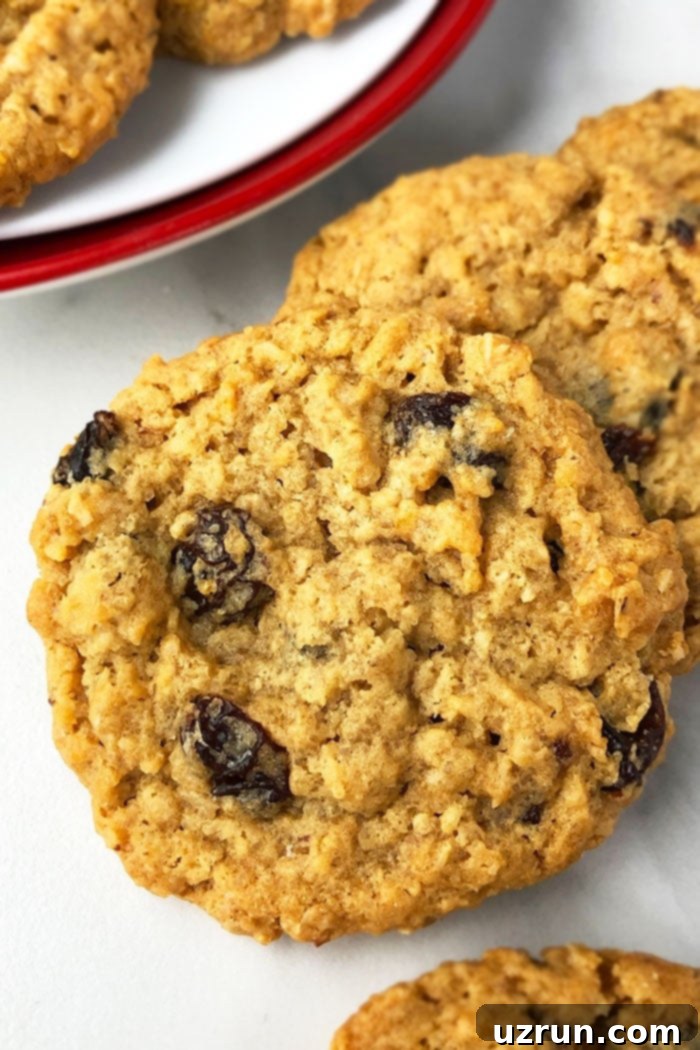
Storage Solutions for Freshly Baked Goodness
Ensuring your oatmeal raisin cookies stay fresh and delicious for as long as possible is key. Proper storage methods can extend their shelf life and maintain their delightful texture.
- Room Temperature: Once completely cooled, store your baked cookies in an airtight cookie jar or container at room temperature. They will remain wonderfully soft and chewy for up to 3 days. This method is perfect for short-term enjoyment.
- Refrigerate: For slightly longer storage, place the cooled cookies in a sealed container in the refrigerator. They will keep well for up to 1 week. Bring them to room temperature or warm them slightly in the microwave for a few seconds before serving to restore their original softness.
- Freeze (Baked): If you’ve baked a large batch and want to enjoy them over an extended period, cooled cookies can be frozen. Place them in a single layer on a baking sheet to freeze solid, then transfer them to an airtight freezer-safe bag or container. They will last for up to 2-3 months. Thaw at room temperature or gently reheat.
- Freeze (Unbaked Dough): A fantastic way to have fresh cookies on demand! Form the dough into balls as usual, then place them on a parchment-lined baking sheet and freeze until solid. Once frozen, transfer the cookie dough balls to a sealed freezer-safe bag or container. They can be stored for up to 1 month. When you’re ready to bake, simply place the frozen dough balls on a baking sheet and add 3-4 extra minutes to the baking time. This method ensures you always have warm, fresh-from-the-oven cookies ready in minutes.
Expert Tips and Techniques for Unforgettable Oatmeal Raisin Cookies
Achieving the perfect soft and chewy oatmeal raisin cookie is an art form, but with these expert tips and techniques, you’ll be baking like a pro in no time. Pay attention to these details for truly exceptional results.
- Avoid Over-mixing the Dough: As highlighted earlier, this is paramount. Over-mixing develops gluten, which leads to tough, dry cookies. Mix your wet and dry ingredients just until they are combined. Some flour streaks are okay; better slightly under-mixed than over-mixed.
- Sift Dry Ingredients: For a consistently smooth dough and to prevent pockets of unmixed flour or spices, sift all your dry ingredients (flour, cinnamon, nutmeg, baking soda) before adding them to the wet mixture. This ensures even distribution and eliminates clumps.
- Knowing When Cookies Are Done: The key to chewy cookies is not overbaking. Use a spatula to gently touch the sides of the cookies. If they are golden brown and firm, they are ready. Crucially, the centers should still appear slightly soft or underdone. They will continue to set as they cool on the baking sheet.
- The Oat Choice Matters: For that signature soft and chewy texture, old-fashioned rolled oats are non-negotiable. Steel-cut oats are far too dense and will result in a hard, unpleasant cookie texture. Quick or instant oats, while faster to cook, break down too much and won’t give you the desired chewiness or hearty texture.
- Use Real Butter: Do not substitute butter with oil or margarine. Butter provides unparalleled flavor, richness, and contributes significantly to the cookie’s texture. Using alternatives will dramatically alter the taste and consistency of your cookies. Ensure your butter is at room temperature for optimal creaming with the sugars.
- Adjust Spices and Extracts: This recipe uses classic cinnamon and nutmeg, along with vanilla extract. Feel free to customize these to your liking. You could add a pinch of ground cloves, ginger powder, or allspice for a warmer, more complex flavor profile. Adjust quantities based on your preference for a bolder or milder spice note.
- Black Raisins vs. Golden Raisins: Both types of raisins can be used, and the choice largely comes down to personal preference. Traditionally, black raisins are used, offering a richer, slightly more intense sweetness. Golden raisins tend to be a bit plumper and have a lighter, fruitier flavor. Either will work beautifully in this recipe.
- The Power of Both Sugars: This recipe calls for both granulated and brown sugar for a reason. Granulated sugar provides crispness and helps the cookies spread slightly, while brown sugar (which contains molasses) adds moisture, chewiness, and a deeper caramel-like flavor. Using both creates the perfect balance.
- Chill the Dough – Don’t Skip It!: Chilling the dough is one of the most important steps for perfectly shaped, thick cookies. It solidifies the butter, which prevents the cookies from spreading too much and becoming flat during baking. It also allows the flavors to deepen and the dough to become less sticky, making it much easier to roll into uniform balls.
- Baking Soda Only: Notice there’s no baking powder in this recipe, only a small quantity of baking soda. Baking soda reacts with the acidic brown sugar and molasses to provide just enough lift without making the cookies too cakey. Using too many leavening agents would cause these cookies to rise excessively, compromising their classic chewy texture and leading to a puffier, less desirable result.
More Classic Cookie Recipes to Bake and Enjoy
If you’ve enjoyed these oatmeal raisin cookies, you’ll love exploring other beloved cookie classics. Each recipe offers its unique charm and is perfect for satisfying any sweet craving:
- Gooey Butter Cookies
- Easy Sugar Cookies
- Chocolate Chunk Cookies
- Classic No Bake Cookies
- Chocolate Crinkle Cookies
Recipe
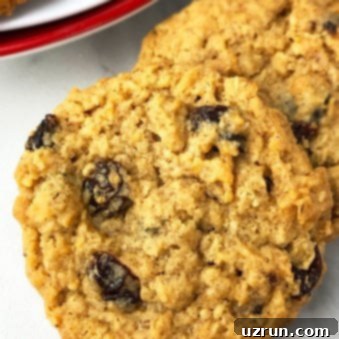
Soft and Chewy Oatmeal Raisin Cookies
Abeer Rizvi
Pin Recipe
Want to Save This Recipe?
Enter your email & I’ll send it to your inbox. Plus, get great new recipes from me every week!
By submitting this form, you consent to receive emails from CakeWhiz
Ingredients
- ½ cup Butter Unsalted, Room temperature
- ½ cup Brown sugar
- ¼ cup Granulated sugar
- 1 Egg Large
- 1 tablespoon Molasses Or honey Or maple syrup
- 2 teaspoon Vanilla extract
- 1 cup All-purpose flour
- 1.5 cups Oatmeal Old-fashioned, Not quick oats
- 1 teaspoon Cinnamon powder
- ¼ teaspoon Nutmeg powder
- ½ teaspoon Baking soda
- ¾ cup Raisins
Instructions
-
In a large mixing bowl, cream together softened unsalted butter, brown sugar, and granulated sugar until the mixture is light, fluffy, and pale in color. This typically takes 2-3 minutes with an electric mixer.
-
Add the large egg, molasses (or your chosen substitute like honey or maple syrup), and pure vanilla extract to the creamed mixture. Mix until all these wet ingredients are fully combined, ensuring a smooth consistency.
-
In a separate bowl, whisk together the all-purpose flour, old-fashioned rolled oats, cinnamon powder, nutmeg powder, and baking soda. Gradually add this dry mixture to the wet ingredients, mixing on low speed until just combined. Be careful not to overmix; some small lumps are acceptable.
-
Gently stir in the raisins by hand using a spatula until they are evenly distributed throughout the dough. The dough will feel quite sticky at this stage.
-
Cover the cookie dough bowl with plastic wrap and chill it in the refrigerator for 30-40 minutes. This chilling period is crucial as it helps the butter solidify, preventing the cookies from spreading too much during baking and making the dough much easier to handle and shape.
-
While the dough is chilling, preheat your oven to 350°F (175°C) and line a baking tray with parchment paper. Once chilled, scoop out small, uniform portions of the dough (about 1.5 tablespoons each) and gently roll them into smooth balls.
-
Place the formed cookie dough balls onto the prepared baking tray, ensuring they are spaced about 2 inches apart to allow for proper spreading during baking.
-
Bake at 350°F (175°C) for 10-12 minutes. The cookies are done when their edges are firm and golden brown, but their centers still appear slightly soft. This slight underbaking in the center ensures a wonderfully chewy texture once cooled.
-
Remove the baking tray from the oven and let the cookies cool completely on the tray. They will continue to set and firm up as they cool. Once fully cooled, transfer them to an airtight container and enjoy!
Notes
- For the best possible results, please thoroughly read all the detailed tips and techniques provided above before you begin baking. These insights will help you achieve that perfect soft and chewy texture.
- Baked leftover cookies can be stored in a sealed, airtight cookie jar or container at room temperature for up to 3 days, maintaining their delicious flavor and softness.
- Consider freezing unbaked cookie dough balls for a convenient way to enjoy freshly baked cookies anytime. Simply add a few extra minutes to the baking time when baking from frozen.
Nutrition
An automated tool is used to calculate the nutritional information. As such, I cannot guarantee the accuracy of the nutritional information provided for any recipe on this site.
